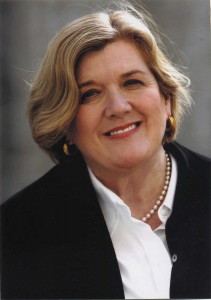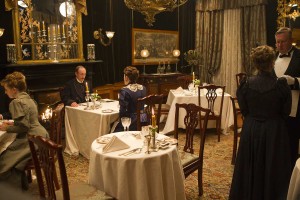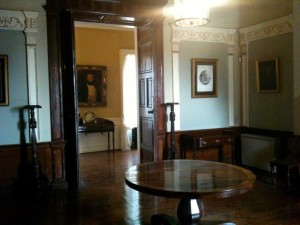
When I ask production designer, Patrizia Von Brandenstein what her mindset is when she begins a period project she immediately answers, “Terror.”
It needn’t be. Patrizia (she’s earned first-name treatment) is a legendary production designer who has demonstrated extreme comfort and dexterity working in any decade in any century in just about any place on Earth.
In Albert Nobbs, she’s designed a closely constricted world in poverty-stricken Dublin, circa 1894, for a hotel headwaiter who is a woman masquerading as a man. The role is a tour de force and a longtime passion for Glenn Close who first played Albert off-Broadway some 20 years ago, and persuaded Patrizia to join her quest to make the film when they were together in Australia in 2000 filming South Pacific for ABC. “Her storytelling was so compelling, and I got intrigued,” Patrizia says.
The two stumped across Europe (Budapest, Berlin) the next summer seeking a locale and talking to financiers about the story of a woman so afraid of falling into poverty and so traumatized by early life events, that she takes on the identity of a man. “It’s an Irish story and once we reached Dublin we knew it couldn’t be done anyplace else,” Patrizia says.
She demurs when asked if Close sought her participation as an inducement to producers, but her filmography was surely an attraction: three movies with director Mike Nichols, including two starring Meryl Streep (Postcards From the Edge, Silkwood); and four films with Milos Foreman, including Goya’s Ghosts, in which Patrizia offered her take on 18th century Spain.
She’s covered New York at the turn of the 20th century (Ragtime) and Chicago in the 1920s (The Untouchables), receiving Oscar nominations for both films.
She’s done 1930’s New York City (Billy Bathgate); 1950’s Louisiana (All the King’s Men); 1970’s Cleveland (Kill the Irishman); and New York again in what was then present-day 1987 (Working Girl).
Recently, in three years (2008-11) she designed 20th century Russia (The Last Station), the present-day Outer Banks of North Carolina, and created a jet-setting take on the present day for Bradley Cooper (Limitless).

Of course she’s best known for her lush depiction of Mozart’s 18th century Vienna in Amadeus, which won her the Oscar for best art direction.
“I guess I’ve been around,” Patrizia admits. “My husband says I can order dinner in 12 languages.”
Producers and directors came and went from Albert Nobbs, but the project didn’t come together until last year when director Rodgrigo Garcia (Passengers, Things You Can Tell by Looking at Her) and his production team came on board.
Approaching the 19th century, Patrizia says, “I didn’t know the specifics of Dublin, but if you have a curiosity about a place and time, and a grounding in history and social culture, you can discover what you need to know.” She researched newspapers, diaries and old flyers as she recreated Albert’s Dublin.
But the key was finding Cabinteely House, a three-story stone house built in 1769 with “wide hallways and multiple runs of bedrooms along those halls, a big, square kitchen and a big back yard surrounded by a stone fence.” The building has been owned and preserved by the Irish government for nearly 100 years.
Asked if it was difficult to work in a 240 year-old building, she says, “It is absolutely more difficult working in a building like that than on a stage,” but with a budget of 6-million euros (well under $10 million at the time) building stage sets was not an option, she says.
The building was used for multiple sets, most of them interiors within the hotel where Albert lives and works, including the set that most defines him, his bedroom. Patrizia created it from a 3rd floor attic, partitioning it in half, limiting it to one small window and a little fireplace. “Because Albert has no life, it was important that we make his room as plain as possible, keep it stripped down and bare. We eliminated everything that could have been a distraction, leaving just a bed and the candle and the money (hidden) in the floor.”

That said, the textures alone of the coarsely woven fabrics on the thin bed linens, especially the pillow case which stands out in one particular scene, hold the eye longer than one would have imagined through Close’s restrained performance.
“That’s all in contrast to the relatively densely decorated interiors throughout the Victorian hotel,” she says. “The hotel has seen better days,” but the look nevertheless derives from a time when everything from carpets to woodwork to furnishings, was far more detailed and ornate.
When she first landed in Ireland, she “was overwhelmed with how many myriad colors of green could possibly exist,” she says. It stayed with me and I wanted at least a little green in every set, with some of them being very green indeed. It makes for lots of very cool backgrounds,” which is appropriate for Albert’s world, “and then when you do include a brilliant spot of color, there is a warmth to it, and it means something,” she says.
The only set that allowed Patrizia to throw open some space, as well as her purse strings, was a tea shop specializing in chocolates where Albert goes on an extraordinarily stiff date. The opulence of the setting, the brightness of the tablecloths and place settings, the height of the ceiling, the commotion of the patrons and the staff, all provide a devastating contrast to Albert’s smallness and containment; it’s a great example of filmmakers at the top of their game working brilliantly in concert with an actor giving a magical performance, to create a stunning movie moment.
It’s been more than 20 years since Patrizia’s last Academy Award nomination. It may be an uphill climb for her here because even though Albert Nobbs takes place in a period whose visuals often scream for attention, the film’s look is by necessity tremendously restrained. The degree to which Patrizia is recognized this season will be in proportion to her peers’ willingness to recognize excellence not in the one more thing added, rather, in the last thing taken away.





